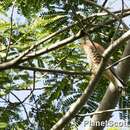en
names in breadcrumbs


The spotted kestrel (Falco moluccensis) is also known as the Moluccan kestrel.
Spread through Wallacea and Java, the spotted kestrel inhabits grasslands with scattered trees, lightly wooded cultivation, and the edges of primary and tall secondary forest. Along logging roads, it occasionally penetrates forests, and sometimes inhabits clearings within forested areas. It has also been known to live in areas of human habitation.[2]
Spotted kestrels measure 26–32 cm (10-12.5 in) from head to tail, with a wingspan of 59–71 cm (23-28 in). On average, spotted kestrels weigh 162 g (5.7 oz).[3] The size difference between male and female is less significant than that of the common kestrels.[4]
In comparison to the common kestrel, the spotted kestrel has darker plumage, paler underparts, and ear-coverts that are more grey.[4] Otherwise, spotted and common kestrels appear very similar to one another.
The spotted kestrel displays similar habits to that of the common kestrel.[5]
The spotted kestrel feeds primarily on small mammals, birds (mostly waterfowl and doves), lizards, and insects.
Displaying similar nesting habits to other kestrels, the spotted kestrel can be found occupying man-made structures, abandoned nests, and cliff sides.[5] In Indonesia, nests were found in a variety of locations, including the peaked roofs of traditional houses or in the crowns of palm trees.[6] Nests are usually occupied from March through September or October during mating season.[5] Similar to other falcons, the spotted kestrel does not build its own nests. Instead, it lays its eggs in abandoned nests built by other raptors or corvids.[3]
The spotted kestrel has a call described as common, a keek, keek, keek, similar to other kestrels. While in flight, they tend to use a more scream-like call, rrrrit, rrrrit, rrrrit.[5]
 A spotted kestrel in flight
A spotted kestrel in flight The spotted kestrel (Falco moluccensis) is also known as the Moluccan kestrel.